Abstract
One of the methods of influence on rheological properties of heavy high-viscosity crude oils is ultrasonic treatment. Ultrasonic treatment allows reducing the viscosity of crude oil and, therefore, reducing the costs of its production and transportation. In this paper, the influence of ultrasonic treatment on the rheological characteristics of crude oil (sample No. 1 API = 29.1, sample No. 2 API = 15.9) was investigated. An experimental method was developed. Experimental studies were carried out using the Physica MCR 102 rheometer. The influence of the intensity and duration of ultrasonic treatment on the viscosity of the initial crude oils was studied for 24 h. In addition, the rheological characteristics of the treated oil were investigated after its natural cooling to 293 K. The results are compared with similar results for thermal heating.
1. Introduction
In countries with cold climate conditions, extraction and following transportation of oil and oil products is a complicated and complex task. As oil extraction, volume of its transportation, and processing increase, the share of high-viscosity oil is steadily increasing in the total volume. In this regard, there are difficulties in the extraction and transportation of oil with such high viscosity, which are caused by their abnormal rheological behavior (Bingham fluids). The peculiarity of rheological properties of such oils appears in the variability of their viscosity, namely, in the nonlinear character the of the shear stress dependence on the shear rate. When transporting high wax crude oil, intensive waxing of pipelines occurs, which leads to large energy overspending for pumping, complicates the technology in general and increases the cost of oil [1]. High wax content crude oil at low temperatures exhibits pronounced non-Newtonian (viscoplastic, viscoelastic, thixotropic) properties; without taking them into account it is impossible to organize the rational operation of wells, gathering, preparation, and transportation of oil [2].
Reduction of viscosity and friction are two primary problems for scientists. The solution to these problems will allow reducing the cost of transportation of high-viscosity oil [3]. The methods of friction reduction include the flow of oil limited by a thin layer of water in the boundary area [4,5] and the use of various additives [6,7,8,9]. Methods of viscosity reduction include heating [10,11,12], ultrasonic treatment [13,14,15,16,17], emulsification of oil in water [18,19,20,21,22], and dilution (mixing with a thinning liquid with lower viscosity, for example, condensate from natural gas extraction, naphtha, kerosene, lighter crude oil, etc.) [23,24,25].
Heating of crude oil can significantly reduce the viscosity of the pumped oil during transportation since the viscosity of the oil depends on the temperature [26]. One of the advantages of this method is to reduce the number of additives and the formation intensity of the gas-hydrate plugs inside the pipeline. It is obvious that the transportation of heated oil is accompanied by the processes of heat exchange with the environment: for pipes with thermal insulation the heat exchange intensity is minimal, but it cannot be neglected in long sections of the pipeline. The heating points of the pumped oil are installed along the pipeline route to maintain oil temperature [27]. The disadvantage of the classical method of oil heating is its high cost [6].
Ultrasonic treatment is the most effective method to regulate of rheological properties of heavy high-viscosity crude oils both from technological and from ecological and economic points of view [28]. For enhanced oil recovery, ultrasonic technologies attract considerable attention due to their simplicity, lower costs, ease of use, and the absence of reservoir contamination. The technology showed improvement of oil production characteristics at the facilities operated in Russia and China [16]. For example, experiments using samples of heavy crude oil from the Shengli oil field (China) show that ultrasonic treatment can reduce the viscosity up to 85%, which contributes to an increase in oil production [28].
The influence of ultrasonic and heat treatment on viscosity, pour point, density, acidity, interfacial tension at the water-oil interface and chemical composition of Ust-Tegusskoe field (Russia) was studied in [29]. It was found that the viscosity of the ultrasound treated oil decreased by 1.7 times, and the pour point became lower by 32 °C compared to similar results for the original oil.
The paper [30] shows the possibility of ultrasonic treatment of heavy oil from Yaregskoe field (Russia) to improve its rheological properties and reduce the viscosity to the values required for the Russian pipeline transport system.
In paper [31], the influence of intensive ultrasonic treatment on the rheological properties of oil and its products is investigated. Rheological properties were monitored for 10 days after ultrasonic treatment. It is established that ultrasonic treatment is able to reduce the viscosity of oil and heavy oil products effectively for a period of time sufficient for their production as well as for transportation over long distances.
In paper [13], it was found that ultrasonic treatment can increase oil extraction by 50% or even more in some cases in wells with a permeability of more than 20 mD and a porosity of more than 15%. The positive effect was observed for 3 to 12 months after treatment. For wells with other permeability and porosity parameters, ultrasonic treatment alone is less successful. Despite the simplicity and environmental safety, according to the authors [13], it is effective in practice only for 85% of cases.
In paper [15], it is noted that the study results of the effect of ultrasonic treatment on the rheological characteristics of oil are numerous and often contradictory.
Viscosity reduction mechanisms of oil treated by ultrasonic mainly include cavitation effect, mechanical vibration, and thermal effect [32]. It is necessary to investigate the oil heating to the same temperature as it was after the ultrasonic treatment to better understand the mechanism of the effect of ultrasonic treatment of oil. Such a study was conducted in [32]. However, residual oil was used in the experiment. In addition, in this work, the necessity to study viscosity over a long period of time is noted. In this work, the rheological behavior of the samples was studied after 48 h. However, sample storage was at 50 °C.
It should be noted that in the paper [33] oil samples were investigated 4 h after ultrasonic treatment. The authors of the paper [33] found that, regardless of the acoustic effect power, a long-term viscosity reduction can be achieved only with the use of sonochemical treatment (about 70%). Ultrasonic treatment in the well leads to a decrease of oil viscosity and at the same time to an increase in oil extraction. Both effects were demonstrated during field experiments in the Republic of Tatarstan: viscosity reduction by 16% 4 h after treatment was observed simultaneously with an increase in oil extraction by 26.5%. Hence, the oil that was supplied into the pipeline near the well was hotter, and the cumulative change in viscosity was based on two factors: the change in the rheological properties of the oil due to ultrasonic treatment and the temperature factor. Also, flow and viscosity curves were built 24.5 h after ultrasonic treatment at a temperature of 293 K.
Mixing of extra heavy oil with light oil as well as ultrasonic treatment (processing time: 5, 10, 15 and 20 min) to reduce viscosity were investigated in the paper [34].
According to [35], during ultrasonic treatment, two mechanisms operate simultaneously: the disintegration of asphaltenes and the combination of free radicals with the formation of new asphaltenes. The optimal duration of ultrasonic treatment is the time at which the formation rate is equal to the decay rate, which is determined for each oil individually.
There are works where ultrasonic treatment of oil and oil products is described at low power values: 20 W [15], 40 W [36], 10–60 W [31], 75 W [35], 100 W [37], and 150 W [38].
For example, in work [36], all samples of light crude oil (20 mL) were exposed to ultrasonic treatment with the power of 40 W and duration up to 10 min. Optimum values of time and radiation power were 2.5 min and 40 W, respectively.
The literature survey has shown that the structural and rheological properties of crude oils of similar component composition change ambiguously after ultrasonic treatment. In addition, there are very few studies that compare ultrasound and heat treatment.
The purpose of this work was to study the rheological properties of oil samples from the Novosheshminskoye field (the Republic of Tatarstan, Russia) after ultrasonic and heat treatment. Heat treatment was carried out to analyze the influence of the temperature factor arising from the ultrasonic treatment. In addition, a change in the viscosity of the samples in 24 h after ultrasound and heat treatment was studied.
2. Materials and Methods
2.1. Materials
Two crude oil samples with the following characteristics were used (Table 1).

Table 1.
Component content of oil samples.
The water content in the samples was determined by Dean–Stark method. The content of components in oil samples is determined according to standard methods. Light fractions were separated from the oils by atmospheric distillation up to 200 °C. Asphalt-free oil was divided into oils and resins by liquid-adsorption column chromatography on silica gel of ASK material grade with sequential elution with a mixture of solvents: n-hexane + carbon tetrachloride (3:1) (eluate is saturated + aromatic); benzene (eluate is non-polar resin) and isopropyl alcohol + benzene (1:1) (eluate—polar resin).
The calculation of the API was produced using the HTR-220CE scale (Shinco Denshi Co. Ltd., Tokyo, Japan).
2.2. Methods
2.2.1. Preliminary Temperature Control of Oil Samples
Temperature is one of the main factors influencing the viscosity of crude oil. The effect of ultrasound on the viscosity of crude oil is lower at a higher temperature and higher at lower temperature [14]. Therefore, the initial samples of crude oil each with volume of 120 mL were thermostated for 30 min in the LOIP FT 311-25 thermostat (LOIP LTD Laboratory Equipment & Instruments, Saint-Petersburg, Russia) at a temperature of 295 K. A similar procedure for oil pretreatment was used in the paper [39]. Then the control measurements of temperature and weight of the samples were made. The temperature was measured using the RM-100 viscometer (LAMY RHEOLOGY, Champagne au Mont d’Or, France) equipped with a probe for temperature measurement. The sample weight was measured with the scales CAS MW-1200 (CAS Corporation, Seoul, South Korea). Oil samples with a temperature deviation of less than 0.2 K and a weight deviation of less than 0.1 g were allowed to ultrasound and heat treatment.
2.2.2. Ultrasonic Treatment
Ultrasonic treatment of crude oil samples was performed using UZTA-0,2/22-OHMS (LLC “Center of ultrasonic technologies”, Biysk, Russia) ultrasonic device. Firstly, 120 mL oil sample was taken and placed in the beaker, the ultrasonic probe was directly inserted in the center of the beaker and about 3/4 depth of the oil sample. The power and duration of exposure were different 80 W, 100 W, and 160 W, and 1 min and 3 min, respectively. At minimum power (80 W) the duration of exposure varied from 1 min to 3 min.
A beaker with an oil sample was placed in a thermal cell made of a heat-insulating material to minimize heat losses during ultrasonic treatment. After completion of the treatment procedure, the temperature was measured using a viscometer equipped with a probe for measuring the temperature. Further, as the samples for the experiment were taken, the beaker with oil continued to be thermostated (the cooling rate did not exceed 1 degree per min according to the recommendations [40,41]). After four hours of thermostating, the remaining volume of oil was poured into a glass container with a sealed lid and left for a day in a place protected from light.
2.2.3. Calorimetric Method for Measurement of Intensity of Ultrasonic Treatment
The calorimetric method [42,43] was used to calculate the intensity of ultrasonic treatment:
where I is the intensity of ultrasound exposure; S is the area of the radiator, cm2; N = Q/t is the power of ultrasonic treatment, W; t is the duration of ultrasonic treatment, s; is the energy spent on oil heating; m is the mass of the heated oil, kg; c is the specific thermal capacity of oil-2100 j·kg−1·K−1, T1 is the oil temperature after ultrasonic treatment, K; T0 is the oil temperature before ultrasonic treatment, K.
The authors of similar works give data on the intensity of ultrasonic treatment of oil calculated for water [42,43]. However, as our calculations show, this approach is approximate. The error of this assumption depends on the rheological and physicochemical properties of crude oil. For the oil samples No. 1 and No. 2 considered in this paper, the average deviation of the values with respect to water was 27.0% and 37.5%, respectively (Figure 1).
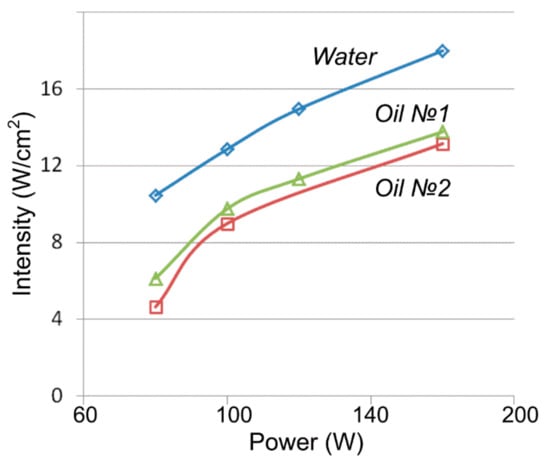
Figure 1.
Dependence of treatment intensity on the power of the ultrasonic device.
2.2.4. Heat Treatment
The results of the study [44] show that the viscosity of liquids decreases under the influence of ultrasound, and it can be explained by heating and cavitation in the liquid. In this paper, the recommendations set out in [32] were adopted, namely, ultrasonic treatment of oil was compared with heat treatment to the same temperatures.
The temperature of the oil after ultrasonic treatment was measured, the VT-8 thermostat (LLC «TERMEX», Tomsk, Russia) was set at the measured temperature, 120 mL of the original oil sample was marked in a beaker and sealed in a thermostat. The duration of the thermostating was 30 min. The viscosity-shear rate curve was measured and compared with that of the oil treated with ultrasound; the results of the experiments were analyzed to obtain the difference between ultrasound and simple heating.
2.2.5. Study of Rheological Properties
Experimental studies were performed on the rheometer Physica MCR 102 («Anton Paar GmbH», Graz, Austria) with the help of the measuring system of coaxial cylinders (SS27) (Figure 2). Temperature control was carried out using Peltier («Anton Paar GmbH», Graz, Austria) elements with the accuracy of 0.01 K.
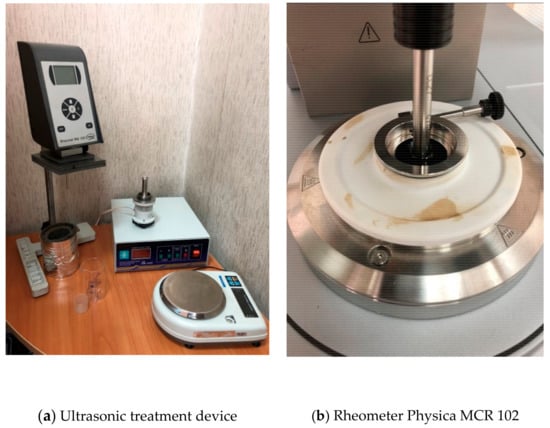
Figure 2.
(a,b) Ultrasonic treatment and viscosity measurement devices.
The preliminary preparation of the measuring system of coaxial cylinders SS27 for the study of oil samples by thermostating in a rheometer was carried out. Thermostating was carried out at a temperature corresponding to the oil temperature after ultrasonic treatment. Distilled water was used during thermostating. The duration of thermostating was at least 10 min.
Determination of the rheological properties of oil samples was carried out immediately after ultrasonic treatment and after 1, 2, 3, and 24 h.
After heat treatment, the study of the rheological properties of the samples was carried out immediately and after 24 h.
3. Results and Discussion
3.1. Rheological Characteristics of the Crude Oils
Figure 3 shows flow curves of original oil samples (No. 1 and No. 2, see Table 1) at the temperature of 293 K. Experimental data showed that the rheological behavior of oil No. 1 is characterized by Newtonian behavior (, ), and oil No. 2 exhibits pseudoplastic properties and it is satisfactorily described by the Power Law model (, ).
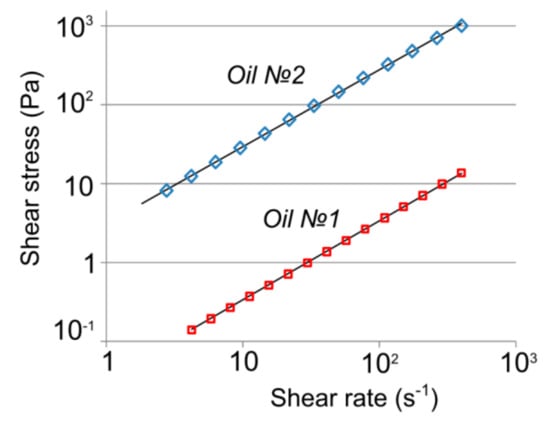
Figure 3.
Dependence of shear stress on shear rate (T = 293 K).
3.2. Analysis of Comparison Experiment
The influence of ultrasonic treatment on the viscosity of oil samples No. 1 and No. 2 was studied for processing for 1 min. The power of ultrasonic treatment was varied: 80 W, 100 W, and 160 W. Figure 4 and Figure 5 show the results. Here, US0 is the dependence of viscosity on shear rate, plotted directly after ultrasonic treatment, US1—after 1 h, US2—after 2 h, US3—after three hours, US 24h—one day after ultrasonic treatment. The influence of heat treatment on the oil viscosity at the temperature reached during ultrasonic treatment of samples was studied.
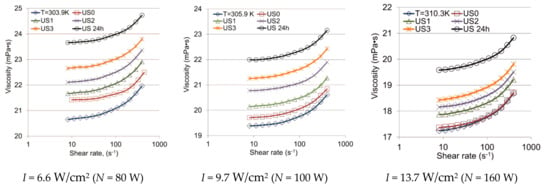
Figure 4.
Dependence of viscosity on shear rate (oil sample No. 1).
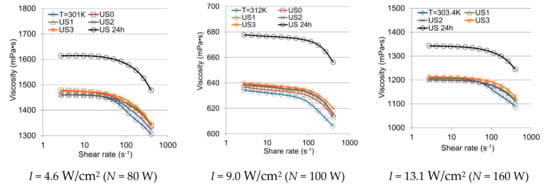
Figure 5.
Dependence of viscosity on shear rate (oil sample No. 2).
When treating the oil sample No. 1, the temperature reached 303.9 K, 305.9 K, and 310.3 K at the intensity of 6.65 W/cm2, 9.75 W/cm2, and 13.76 W/cm2, respectively. Comparison of viscosity curves as a function of shear rate after ultrasonic and heat treatment showed that a decrease in the viscosity of the oil sample was achieved by increasing the temperature.
Heat treatment compared with ultrasonic treatment is more efficient at the impact intensity of 6.65 W/cm2, 9.75 W/cm2.
At the impact intensity of 13.77 W/cm2 (power 160 W), the effect of heat and ultrasonic treatment for oil sample No. 1 is the same.
As the experiment showed, the viscosity of the treated oil increases over time and reaches its highest value after 24 h (for example, the increase was 14.4% relative to the initial sample viscosity at T = 303.9 K). An increase in the ultrasonic treatment intensity leads to a decrease in the difference between US0, US1, US2, US3.
When treating the oil sample No. 2, the temperature reached 301 K, 303.4 K, and 312 K at an intensity of 4.6 W/cm2, 9.0 W/cm2, 13.1 W/cm2, respectively. The difference between the viscosity curves corresponding to ultrasonic (US0, US1, US2, US3) and heat treatment decreases (Figure 5). After ultrasonic treatment, rheological properties remain unchanged for 3 h. However, after 24 h the oil viscosity increases significantly, on average by 11%. The increase in viscosity is caused by irreversible changes in the oil structure and evaporation of light fractions. Despite the fact that the volume of oil was stored in a sealed glass container, evaporation of the light fractions from the liquid phase was possible due to the free volume (the internal volume of the container was three times the volume of oil).
The viscosity of the oil sample No. 1 decreases on average by 20% with the twofold increase in the intensity of ultrasonic treatment. When the intensity of ultrasound exposure increases by 2.8 times, the viscosity of the oil sample No. 2 decreases on average by 2.3 times. Since the effect of heat and ultrasonic treatment for oil samples was almost the same, a study on the increase of the duration of ultrasonic treatment was carried out.
3.3. The Influence of Duration of Ultrasonic Treatment
Duration of ultrasonic treatment was increased to 3 min. Treatment power was 80 W to avoid excessive evaporation of light fractions. The temperature of the oil sample No. 1 after treatment was 315.4 K and for the oil sample No. 2 it was 309.2 K. Figure 6 shows the obtained dependences of viscosities on the shear rate.
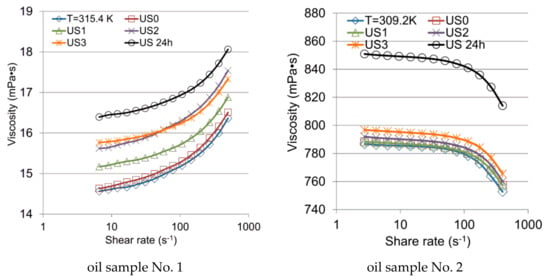
Figure 6.
Dependence of viscosity on shear rate at ∆t = 3 min, N = 80 W.
The intensity of ultrasonic treatment for oil sample No. 1 was 6.6 W/cm2 and for oil sample No. 2, 4.6 W/cm2. The curves of oil viscosity after thermal and ultrasonic treatment are similar for both samples. The expected effect of increasing the duration of ultrasonic treatment was not obtained.
Previously (Figure 4, Figure 5, Figure 6), it was found that the viscosity of the oil treated by ultrasound increases after 24 h. For oil sample No. 2 (Figure 7), the viscosity curves obtained 24 h after thermal and ultrasonic treatment were compared (4.6 W/cm2, ∆t = 3 min).
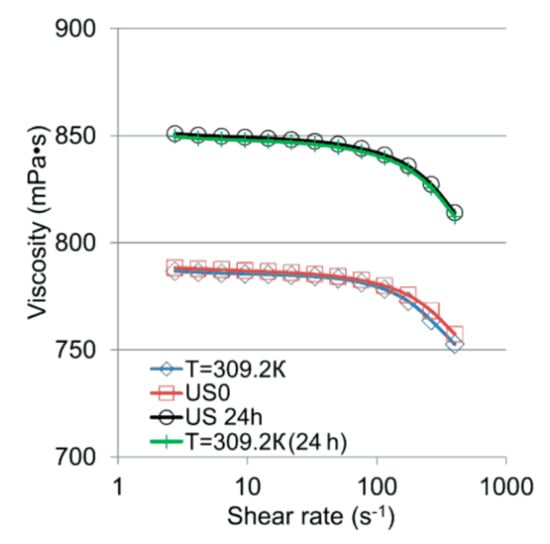
Figure 7.
Dependence of viscosity on shear rate (Oil sample No. 2, ultrasonic parameters: I = 4.6 W/cm2, ∆t = 3 min).
Thus, the obtained results indicate that the viscosity reduction mechanism of the oil treated by ultrasound is only due to the thermal effect.
3.4. Rheological Properties of Oil after Treatment at 24 Hours
Oil transportation is a non-isothermal process accompanied by a change in oil temperature along the pipeline length. Therefore, it is of interest to study the rheological characteristics of the pretreated oil after its natural cooling, for example, up to 293 K. Figure 8 illustrates the effect of ultrasonic power on the viscosity of the studied oil samples after natural cooling. Here the curves W40t1, W50t1, and W80t1 are drawn after 24 h. Abbreviation W40t1 means that ultrasonic treatment is performed at the device power of in 40% (0.4 × 200 W) and duration of t = 1 min. All curves are drawn at a temperature of 293 K.
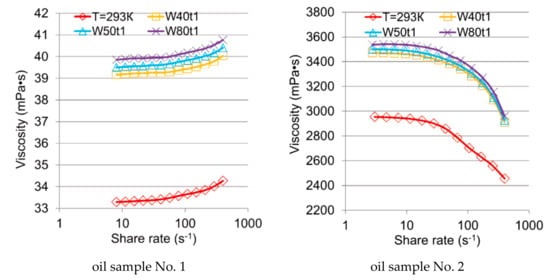
Figure 8.
Dependence of viscosity on shear rate after 24 h (T = 293 K).
As can be seen from Figure 8, ultrasonic treatment after natural cooling within 24 h leads to deterioration of the oil rheological properties. For sample No. 1, the following data were obtained: an increase in oil viscosity by 15% at the power of 80 W, by 18%—at the power of 100 W, by 20%—at the power of 160 W relative to the initial viscosity curve at 293 K. The viscosity of the oil sample No. 2 after ultrasonic treatment increased by 17–19%.
4. Conclusions
In the course of experimental research on the ultrasonic and heat treatment influence on the rheological properties of two oil samples from the Novosheshminskoye field (Russia) with API 15.9 and 29.1, the following results were obtained:
- The intensity of ultrasonic treatment depends on the initial rheological properties of crude oil. The increase in the viscosity of the initial oil complicates the convective mixing of the layers because of cavitation, while the liquid heating is localized near the surface of the ultrasound source. All of this leads to a decrease in the intensity of ultrasonic treatment.
- The viscosity of oil sample No. 1 is reduced by 20% when the intensity of ultrasonic treatment is 13.76 W/cm2. Heat treatment is more effective than ultrasonic treatment at impact intensity up to 13.76 W/cm2. When the intensity of the ultrasonic treatment increases, the viscosity reduction mechanism of the oil treated by ultrasound is only due to the thermal effect.
- When the intensity of ultrasonic exposure is 13.1 W/cm2, the viscosity of the oil sample No. 2 decreases on average by 2.3 times. In all of the experiments carried out with this oil sample, the effect of heat and ultrasonic treatment is the same.
- The viscosity of oil samples increases in all considered cases at 24 h after ultrasonic and heat treatment.
Author Contributions
Conceptualization: A.K.; formal analysis: A.K.; investigation: A.K. and J.K.; methodology: A.K. and J.K.; validation: A.K. and J.K.; writing—original draft: A.K.
Funding
The reported study was funded by RFBR, project number 18-31-20037.
Conflicts of Interest
The authors declare no conflicts of interest.
References
- El-Dalatony, M.M.; Jeon, B.H.; Salama, E.S.; Eraky, M.; Kim, W.B.; Wang, J.; Ahn, T. Occurrence and Characterization of Paraffin Wax Formed in Developing Wells and Pipelines. Energies 2019, 12, 967. [Google Scholar] [CrossRef]
- Kazantsev, O.A.; Volkova, G.I.; Prozorova, I.V.; Litvinets, I.V.; Orekhov, D.V.; Samodurova, S.I.; Kamorin, D.M.; Moikin, A.A.; Medzhibovskii, A.S. Poly(alkyl (meth)acrylate) depressants for paraffin oils. Pet. Chem. 2016, 56, 68–72. [Google Scholar] [CrossRef]
- Livinus, A.; Yeung, H.; Lao, L.Y. Restart time correlation for core annular flow in pipeline lubrication of high-viscous oil. J. Pet. Explor. Prod. Technol. 2017, 7, 293–302. [Google Scholar] [CrossRef][Green Version]
- Crivelaro, K.C.O.; Damacena, Y.T.; Andrade, T.H.F.; Lima, A.G.B.; Neto, S.R.F. Numerical simulation of heavy oil flows in pipes using the core-annular flow technique. Comput. Methods Multiph. Flow V 2009, 63, 193–203. [Google Scholar] [CrossRef]
- Gadelha, A.J.F.; Neto, S.R.F.; Swarnakar, R.; Lima, A.G.B. Thermo-Hydrodynamics of Core-Annular Flow of Water, Heavy Oil and Air Using CFX. Adv. Chem. Eng. Sci. 2013, 3, 37–45. [Google Scholar] [CrossRef]
- Hart, A. A review of technologies for transporting heavy crude oil and bitumen via pipelines. J. Pet. Explor. Prod. Technol. 2014, 4, 327–336. [Google Scholar] [CrossRef]
- Gudala, M.; Banerjee, S.; Kumar, A.; Rao, T.R.M.; Mandal, A.; Naiya, T.K. Rheological modeling and drag reduction studies of Indian heavy crude oil in presence of novel surfactant. Pet. Sci. Technol. 2017, 35, 2287–2295. [Google Scholar] [CrossRef]
- Nesyn, G.V.; Shibaev, V.P.; Sunagatullin, R.Z.; Malkin, A.Y. Drag reduction in transportation of hydrocarbon liquids: From fundamentals to engineering applications. J. Pet. Sci. Eng. 2018, 8, 309–325. [Google Scholar] [CrossRef]
- Wang, Z.H.; Yu, X.Y.; Li, J.X.; Wang, J.G.; Zhang, L. The Use of Biobased Surfactant Obtained by Enzymatic Syntheses for Wax Deposition Inhibition and Drag Reduction in Crude Oil Pipelines. Catalysts 2016, 6, 61. [Google Scholar] [CrossRef]
- Tiwari, A.K.; Jha, S.K.; Kumar, R. Transportation of Heavy Crude Oils through Heated Pipeline-Assessment of Relative Economics. In Proceedings of the 10th Pipeline Technology Conference Estrel Convention Center, Berlin, Germany, 8–10 June 2015. [Google Scholar]
- Dunia, R.; Edgar, T.F. Study of Heavy Crude Oil Flows in Pipelines with Electromagnetic Heaters. Energy Fuels 2012, 26, 4426–4437. [Google Scholar] [CrossRef]
- Wei, L.; Lei, Q.; Zhao, J.; Dong, H.; Yang, L. Numerical simulation for the heat transfer behavior of oil pipeline during the shutdown and restart process. Case Stud. Therm. Eng. 2018, 12, 470–483. [Google Scholar] [CrossRef]
- Abramov, V.O.; Mullakaev, M.S.; Abramova, A.V.; Esipov, I.B.; Mason, T.J. Ultrasonic technology for enhanced oil recovery from failing oil wells and the equipment for its implemention. Ultrason. Sonochem. 2013, 20, 1289–1295. [Google Scholar] [CrossRef] [PubMed]
- Wang, Z.; Xu, Y.; Suman, B. Research status and development trend of ultrasonic oil production technique in China. Ultrason. Sonochem. 2015, 26, 1–8. [Google Scholar] [CrossRef] [PubMed]
- Volkova, G.I.; Anufriev, R.V.; Yudina, N.V. Effect of ultrasonic treatment on the composition and properties of waxy high-resin oil. Pet. Chem. 2016, 56, 683–689. [Google Scholar] [CrossRef]
- Avvaru, B.; Venkateswaran, N.; Uppara, P.; Iyengar, S.B.; Katti, S.S. Current knowledge and potential applications of cavitation technologies for the petroleum industry. Ultrason. Sonochem. 2018, 42, 493–507. [Google Scholar] [CrossRef] [PubMed]
- Xin, X.; Li, Y.; Yu, G.; Wang, W.; Zhang, Z.; Zhang, M.; Ke, W.; Kong, D.; Wu, K.; Chen, Z. Non-Newtonian Flow Characteristics of Heavy Oil in the Bohai Bay Oilfield: Experimental and Simulation Studies. Energies 2017, 10, 1698. [Google Scholar] [CrossRef]
- Abdurahman, N.H.; Rosli, Y.M.; Azhari, N.H.; Hayder, B.A. Pipeline transportation of viscous crudes as concentrated oil-in-water emulsions. J. Pet. Sci. Eng. 2012, 90, 139–144. [Google Scholar] [CrossRef]
- Wong, S.F.; Lim, J.S.; Dol, S.S. Crude oil emulsion: A review on formation, classification and stability of water-in-oil emulsions. J. Pet. Sci. Eng. 2015, 135, 498–504. [Google Scholar] [CrossRef]
- Hoshyargar, V.; Marjani, A.; Fadaei, F.; Shirazian, S. Prediction of Flow Behavior of Crude Oil-in-Water Emulsion through the Pipe by Using Rheological Properties. Orient. J. Chem. 2012, 28, 109–113. [Google Scholar] [CrossRef]
- Loh, W.L.; Premanadhan, V.K. Experimental investigation of viscous oil-water flows in pipeline. J. Pet. Sci. Eng. 2016, 147, 87–97. [Google Scholar] [CrossRef]
- Luo, X.; Lu, G.; Zhang, W.; He, L.; Lu, Y. Flow structure and pressure gradient of extra heavy crude oil-water two-phase flow. Exp. Therm. Fluid Sci. 2017, 82, 174–181. [Google Scholar] [CrossRef]
- Li, S.; Huang, Q.; Fan, K.; Zhao, D.; Lv, Z. Transportation technology with pour point depressant and wax deposition in a crude oil pipeline. Pet. Sci. Technol. 2016, 34, 1240–1247. [Google Scholar] [CrossRef]
- Martinez-Palou, R.; Reyes, J.; Ceron-Camacho, R.; Ramirez-de-Santiago, M.; Villanueva, D.; Vallejo, A.A.; Aburto, J. Study of the formation and breaking of extra-heavy-crude-oil-in-water emulsions-A proposed strategy for transporting extra heavy crude oils. Chem. Eng. Process. 2015, 98, 112–122. [Google Scholar] [CrossRef]
- Ilyin, S.O.; Arinina, M.P.; Polyakova, M.Y.; Kulichikhin, V.G.; Malkin, A.Y. Rheological comparison of light and heavy crude oils. Fuel 2016, 186, 157–167. [Google Scholar] [CrossRef]
- Martinez-Palou, R.; Mosqueira, M.D.L.; Zapata-Rendon, B.; Mar-Juarez, E.; Bernal-Huicochea, C.; Clavel-Lopez, J.D.L.C.; Aburto, J. Transportation of heavy and extra-heavy crude oil by pipeline: A review. J. Pet. Sci. Eng. 2011, 75, 274–282. [Google Scholar] [CrossRef]
- Zhou, M.; Zhang, Y.; Jin, S. Dynamic optimization of heated oil pipeline operation using PSO-DE algorithm. Measurement 2015, 59, 344–351. [Google Scholar] [CrossRef]
- Hua, Q.; Tan, D.; Chen, L.; Tian, S.; Hu, Y. Ultrasonic irradiation reduces Shengli heavy oil viscosity. Oil Gas J. 2017, 115, 46–49. [Google Scholar]
- Mullakaev, M.S.; Asylbaev, D.F.; Prachkin, V.G.; Volkova, G.I. Influence of Ultrasound and Heat Treatment on the Rheological Properties of Ust-Tegusskoe Oil. Chem. Pet. Eng. 2014, 49, 584–587. [Google Scholar] [CrossRef]
- Zemenkov, Y.D.; Zemenkova, M.Y.; Berg, V.I.; Gordievskaya, E.F. Technology of Ultrasonic Treatment of High-Viscosity Oil from Yarega Oilfield to Improve the Rheological Properties of Oil. In Proceedings of the International Scientific-Practical Conference of Students, Graduate Students and Young Scientists on Transport and Storage of Hydrocarbons, Tyumen, Russia, 20–25 May 2016. [Google Scholar]
- Makarev, D.I.; Rybyanets, A.N.; Sukhorukov, V.L. Effects of different power high-intensity ultrasonic treatment on rheological properties of heavy oil products. Indian J. Sci. Technol. 2016, 9, 1–7. [Google Scholar] [CrossRef][Green Version]
- Huang, X.; Zhou, C.; Suo, Q.; Zhang, L.; Wang, S. Experimental study on viscosity reduction for residual oil by ultrasonic. Ultrason. Sonochem. 2018, 41, 661–669. [Google Scholar] [CrossRef]
- Abramov, V.O.; Abramova, A.V.; Bayazitov, V.M.; Mullakaev, M.S.; Marnosov, A.V.; Ildiyakov, A.V. Acoustic and sonochemical methods for altering the viscosity of oil during recovery and pipeline transportation. Ultrason. Sonochem. 2017, 35, 389–396. [Google Scholar] [CrossRef] [PubMed]
- Rahimi, M.A.; Ramazani, A.S.A.; Alijanvand, H.A.; Ghazanfari, M.H.; Ghanavati, M. Effect of ultrasonic irradiation treatment on rheological behaviour of extra heavy crude oil: A solution method for transportation improvement. Can. J. Chem. Eng. 2017, 95, 83–91. [Google Scholar] [CrossRef]
- Najafi, I.; Amani, M. Asphaltene Flocculation Inhibition with Ultrasonic Wave Radiation: A Detailed Experimental Study of the Governing Mechanisms. Adv. Pet. Explor. Dev. 2011, 2, 32–36. [Google Scholar] [CrossRef]
- Salehzadeh, M.; Akherati, A.; Ameli, F.; Dabir, B. Experimental study of ultrasonic radiation on growth kinetic of asphaltene aggregation and deposition. Can. J. Chem. Eng. 2016, 94, 2202–2209. [Google Scholar] [CrossRef]
- Sivagami, K.; Anand, D.; Divyapriya, G.; Nambi, I. Treatment of petroleum oil spill sludge using the combined ultrasound and Fenton oxidation process. Ultrason. Sonochem. 2019, 51, 340–349. [Google Scholar] [CrossRef]
- Yi, M.X.; Huang, J.; Wang, L.F. Research on Crude Oil Demulsification Using the Combined Method of Ultrasound and Chemical Demulsifier. J. Chem. 2017, 2017, 1–7. [Google Scholar] [CrossRef]
- Mullakaev, M.S.; Volkova, G.I.; Gradov, O.M. Effect of ultrasound on the viscosity-temperature properties of crude oils of various compositions. Theor. Found. Chem. Eng. 2015, 49, 287–296. [Google Scholar] [CrossRef]
- Mendes, R. Rheological Behavior and Modeling of Waxy Crude Oils in Transient Flows; Université of Paris-Est: Champs-sur-Marne, France, 2015. [Google Scholar]
- Malkin, A.Y.; Khadzhiev, S.N. On the Rheology of Oil (Review). Pet. Chem. 2016, 56, 541–551. [Google Scholar] [CrossRef]
- Plattes, M.; Kohler, C.; Galle, T. Disequilibrium calorimetry for determination of ultrasonic power in sonochemistry. Methodsx 2017, 4, 274–278. [Google Scholar] [CrossRef]
- O’Sullivan, J.; Murray, B.; Flynn, C.; Norton, I. Comparison of batch and continuous ultrasonic emulsification processes. J. Food Eng. 2015, 167, 114–121. [Google Scholar] [CrossRef]
- Hamidi, H.; Mohammadian, E.; Junin, R.; Rafati, R.; Azdarpour, A.; Junid, M.; Savory, R.M. The Effect of Ultrasonic Waves on Oil Viscosity. Pet. Sci. Technol. 2014, 32, 2387–2395. [Google Scholar] [CrossRef]
© 2019 by the authors. Licensee MDPI, Basel, Switzerland. This article is an open access article distributed under the terms and conditions of the Creative Commons Attribution (CC BY) license (http://creativecommons.org/licenses/by/4.0/).